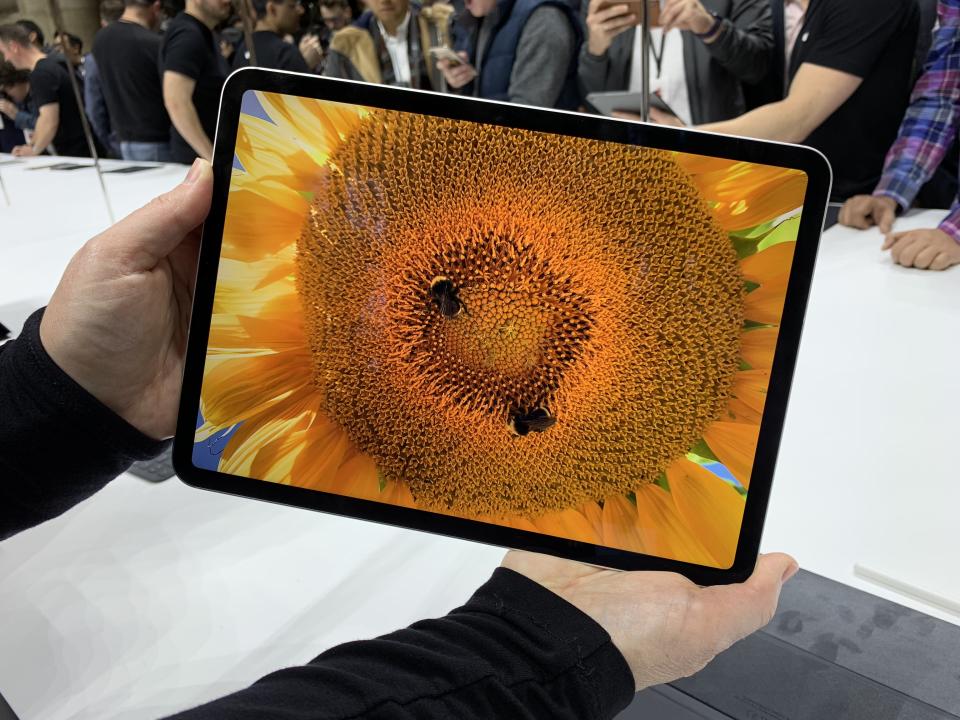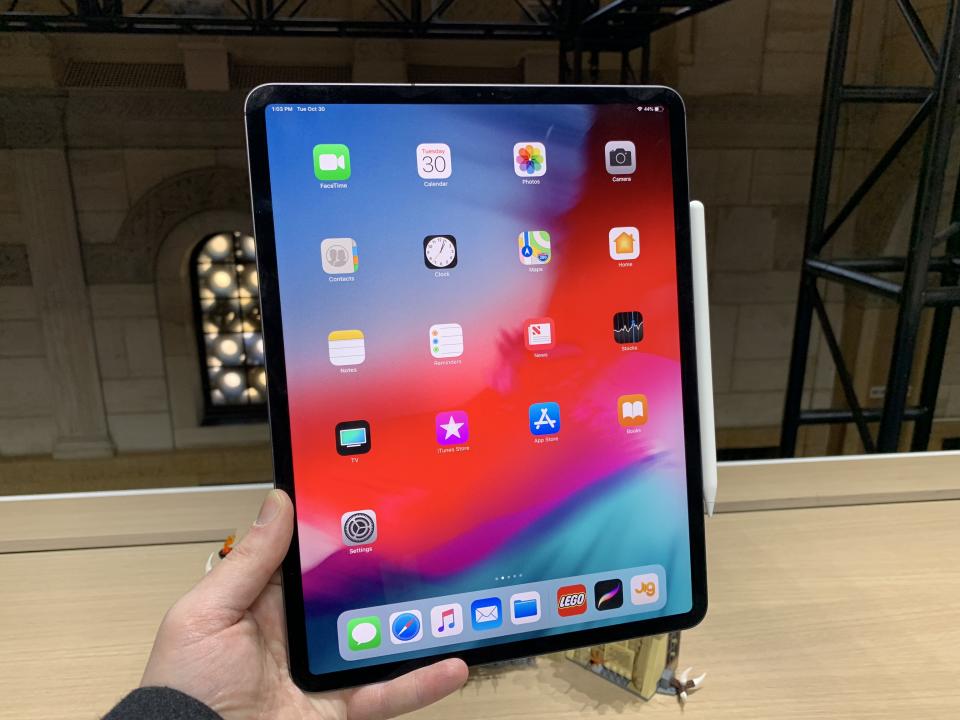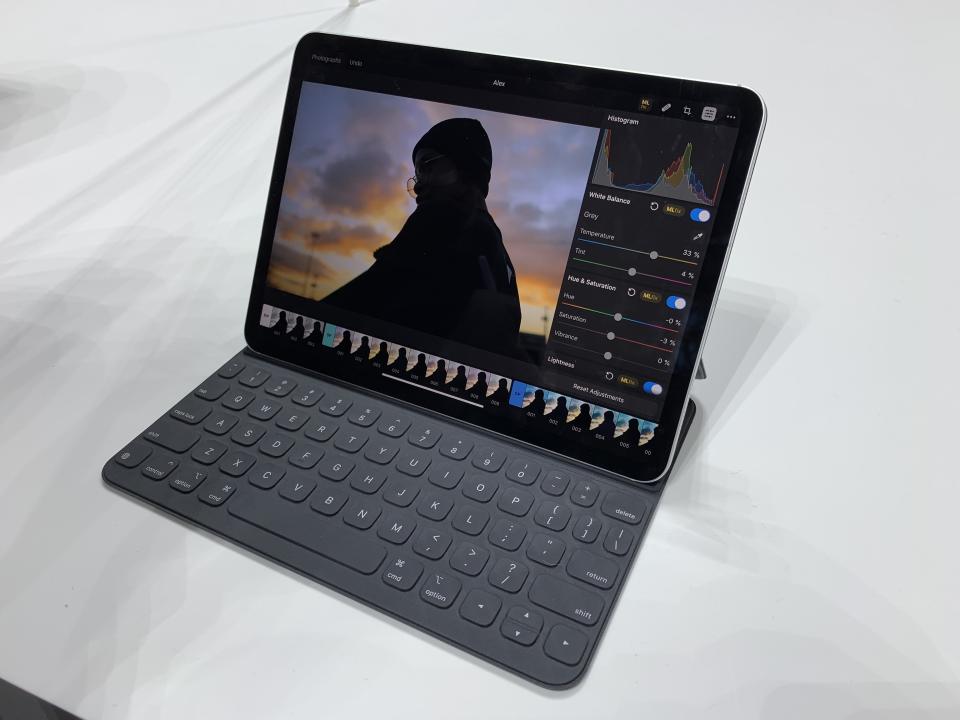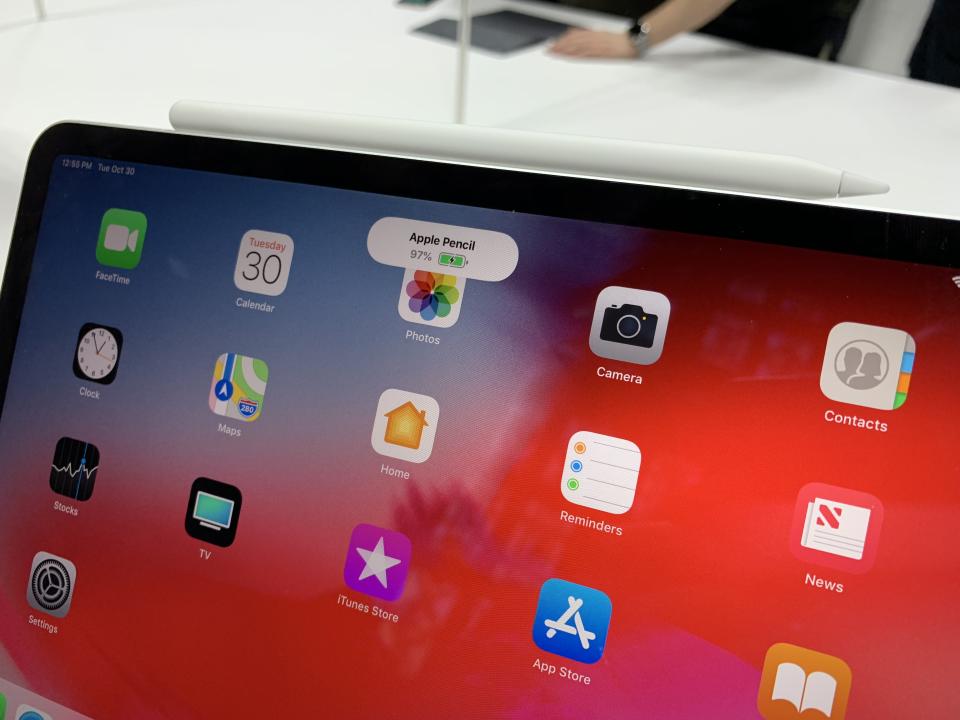Apple’s iPad Pro just got a heck of a facelift

Apple’s (AAPL) iPad Pro, the high-powered slate that Apple says can replace your laptop — but not your MacBook, of course — is changing. It now more closely resembles the company’s iPhone XS and XS Max than the original iPad.
Unveiled Tuesday in Brooklyn, New York, the new iPad Pro packs an edge-to-edge display and ditches its Touch ID fingerprint sensor for the Face ID camera used in recent iPhones. It’s a dramatic upgrade for the iPad line, and with a starting price of $799 for the new 11-inch model and $999 for the 12.9-inch version, it’s not cheap. But after spending some hands-on time with it, the new Pro looks like it might be the best tablet Apple has ever made.
To the edge
Like the new iPhone XR, the updated iPad Pro uses Apple’s Liquid Retina Display. Basically that means it’s an LCD panel that Apple managed to curve around the device’s edges to make for smooth, round corners. Since this is an LCD panel, it won’t produce the kind of inky blacks and vibrant colors the XS and XS Max offer, but your images will look great nonetheless. In fact, if you’ve used an iPad in the last few years you shouldn’t notice a difference.
While the Pros have an incredibly slim bezel running around their screens, they’re still not as edge-to-edge as the iPhones. The remaining bezel isn’t just necessary for the lighting elements in the displays, but to provide you with a means of holding the tablet without touching the screen by accident. A phone can have a truly edge-to-edge screen because you can wrap your hands around it entirely. A tablet not so much.

The edge-to-edge screen also means that Apple had to kill off the iPad Pro’s Home button. And I don’t miss it in the least. Face ID on the XR, X, XS and XS Max is responsive and easy to use. And if getting rid of the Home button means more screen real estate, sign me up.
In fact, Face ID on the iPad Pro is even better than on the iPhone, because you can use it in any orientation. That’s right — instead of having to hold your device in portrait mode when you use Face ID on your iPhone, you can use it in landscape, portrait or anything in between on the iPad Pro. It makes sense for Apple to add that capability to the iPad since, as company reps put it, there’s no right way to hold the tablet. Face ID on the iPhone only works when the phone is in portrait orientation.
Thanks to those edge-to-edge screens, Apple was able to play with the size of the new Pros, too. The new 12.9-inch model has a far smaller footprint. Apple says it has 25% less volume than the previous generation 12.9-inch Pro. That’s a big improvement, because, frankly, the older 12.9-inch Pro was just too big to for me. Don’t get me wrong, it’s still a big slate, but it’s definitely easier to handle than the original.

Then there’s the new 11-inch iPad Pro, which is basically the old 10.5-inch Pro with it’s screen stretched to the edges. This is the one that I’d feel comfortable buying, since you can easily hold it with one hand. Apple also sells the older 10.5-inch Pro, but it doesn’t get any of the benefits of the new models like a faster processor or Face ID.
Powered up
The Pros’ new screens might get all of the attention, but it’s really the slates’ processors that put the new models ahead. Both the 12.9-inch and 11-inch Pros come with Apple’s new A12X Bionic chip, a 7-nanometer, 8-core processor with 10 billion transistors. If all of that sounds like nonsense to you, then how about this: Apple claims the A12X Bionic chip makes the Pros faster than 92% of notebooks sold in the last year, even those with Intel Core i7 processors.
That’s a heck of a lofty claim, and there wasn’t anything I could really test on the Pro during my hands-on to put the processor through its paces, so I can’t verify the slate’s performance quite yet. But if true, that would be an incredible feat.
Apple also claims that the iPad Pro’s graphics processing unit is capable of delivering graphics that are on a par with Microsoft’s Xbox One S. Again, that’s a serious statement, and while a demo of 2K Games’s “NBA 2K19” looked fantastic, I’d like to play it on my own to see if it runs as smoothly as it looked on stage.
As far as storage capacity goes, the new iPads start out at 64GB, jump to 256GB, then 512GB and finally a whopping 1TB. But for that much space, you’ll spend a pretty penny. The 11-inch Pro with 1TB of space costs $1,549, while the 12.9-inch will set you back $1,749.
Pencil me in
Since Apple is upgrading the Pro, it’s also upgrading the Apple Pencil. This time around the Pencil can attach to the side of the Pro magnetically, which is something Microsoft’s Surface Pro also does. But the iPad Pro also charges and pairs the Pencil while attached.

There’s also a new double-tap feature that lets you quickly switch between writing and drawing tools in specific apps. You simply double tap the side of the Pencil and, voila, you’ve switched tasks.
Perhaps most surprising of all — okay, not really if you followed the leaks, but still — is the fact that Apple has switched out its proprietary Lightning port for a USB C connector. That’s big news because it means that you can connect a slew of new peripherals to the iPad Pro, including a digital camera, a display or even a cable to charge your iPhone. This could be a big deal for the Pro and open up a world of new use-cases in the future.
So should you snag a Pro for yourself? It’s expensive, sure, but it certainly seems like a fantastic device. Stay tuned for my full review to see if you should cut a check for this slate.
Editor’s note: This piece previously stated that the A12X Bionic chip has 10 million transistors. It actually has 10 billion.
More from Dan:
Apple unveils redesigned iPad Pros with edge-to-edge displays
IBM CEO on Red Hat: ‘There’s a $1 trillion market in front of us’
Email Daniel Howley at [email protected]; follow him on Twitter at @DanielHowley. Follow Yahoo Finance on Facebook, Twitter, Instagram, and LinkedIn
